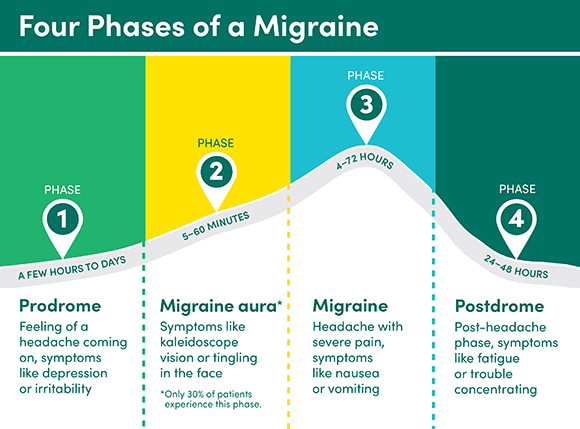Don't Suffer in Silence: Understanding Migraines

If you suffer from recurring or chronic migraines, you know the pain can be debilitating. It’s not simply headache pain – it’s a neurological disease that can keep you from being able to work, take care of yourself and enjoy life.
While migraine pain might make you feel helpless, you’re not alone. There are an estimated 40 million people in the US suffering from migraines.† AHN’s neurology providers are here to offer you solutions for relief.
Ending migraine stigma, optimizing care
For many years, migraine sufferers weren’t taken seriously because of a lack of research and broader awareness about the seriousness of this condition. Although migraine stigma still exists today, neurologists have made incredible strides in understanding, treating and preventing migraines.
Migraine and headache specialists at AHN’s Neuroscience Institute and AHN Headache Center use this knowledge to develop a personalized treatment plan for every patient.
Decoding migraines
It’s important to first understand how migraines are different from other headaches, as well as migraine types and phases.
Common headaches: Common headaches involve unpleasant pain in the head that can cause pressure and aching.
- Tension headache – Pain is felt in a band-like shape around the head
- Cluster headache – Pain is felt around one eye
Migraines: Migraines are classified by pain on one side of the head (unilateral), paired with symptoms like nausea, vomiting and visual changes.
- Chronic migraine – Classified by more than 15 headache days a month and eight days involving migraine features.
- Episodic migraine – Less frequent waves of migraines followed by a return to normalcy. When not treated properly, episodic attacks can grow into chronic migraines over time.
Visualizing migraine phases
There are four phases of symptoms that individuals can experience during a migraine attack.
Phase 1: Prodrome
Feeling of a headache coming on, symptoms like depression or irritability.
Phase 2: Migraine aura
Symptoms like kaleidoscope vision or tingling in the face.
Phase 3: Migraine
Headache with severe pain, symptoms like nauseas or vomiting.
Phase 4: Postdrome
Post-headache phase, symptoms like fatigue or trouble concentrating.
Identifying triggers
Migraines can be triggered by a variety of factors, some that you can control or change (modifiable) and some that you can’t change but may be able to manage differently (non-modifiable).
Identifying triggers for your migraines is important when working with your health care provider to find a diagnosis. Next time you feel a migraine coming on, write down any of the factors listed below that you think could have caused it. Use this list to start a conversation with your AHN provider.
Common modifiable factors:
- Diet and hydration.
- Sleep patterns.
- Stress and mental health.
- Medications and caffeine use.
- Hormonal changes (to some extent).
- Environmental factors such as bright lights, screen exposure, strong smells and loud noises.
Common non-modifiable factors:
- Genetics – People with a family history of migraines have a higher likelihood of experiencing them.
- Gender – Women are more likely to experience migraines, particularly due to hormonal fluctuations.
- Weather and barometric pressure changes – Storms, extreme heat or sudden pressure shifts can all trigger migraines.
Treatment and prevention plans
Thanks to major advancements in migraine research, there are now more options than ever to find migraine relief and prevent future attacks.
At home, you can safely manage migraines by maintaining a calm environment with low or no lighting, sleeping and eating well, exercising, and taking medications prescribed by a headache specialist.
Physicians at the Headache Center use a multidisciplinary approach, collaborating with other providers such as OBGYNs or psychiatrists to address each patient’s physical, mental and emotional needs.
Common treatment methods include:
- Medication management – Medications have evolved significantly over the years, and you now not only have access to options that stop a migraine in progress, but also preventive treatments that can reduce frequency and severity.
- Lifestyle modifications – Proper diet, exercise and sleep habits can help reduce your migraines.
- Botox® injections – Once thought of only for cosmetic use, Botox is now an FDA-approved treatment option for many chronic migraine sufferers. It works by blocking nerve signals that trigger pain.
- IV migraine treatment – This procedure where fluids are distributed directly into the bloodstream via a vein, can provide you with faster pain relief.
When is it time to see a doctor?
Many migraine sufferers can treat their symptoms at home effectively with over-the-counter (OTC) medicine. When OTC medicine stops being effective, it’s important to schedule an appointment with your doctor.
Don’t suffer in silence. Based on your symptoms and needs, our specialized neurology team at AHN’s Headache Center is here to evaluate your condition and tailor a treatment plan specifically for you.
Botox® is a registered trademark of Allergan, Inc. and is used with permission.
Source: Behind the Migraine: Pfizer Colleagues Share Their Stories. pfizer.com.
Source: Migraine and Aura. americanmigrainefoundation.org
Certified by the American Board of Psychiatry and Neurology, Dr. Santamaria is the director of the Headache Center at Allegheny Health Network (AHN). She is certified as a headache specialist by the United Council for Neurologic Subspecialties and is committed to providing patients with personalized and compassionate expertise through multifaceted treatments and care.
At Allegheny Health Network (AHN) Neuroscience Institute, our neurology team includes physicians who focus on headache care. Based on your symptoms and needs, we tailor a treatment plan specifically for you using research-backed treatments and novel medications. We get you headache relief today while also working with you to prevent future headaches.



